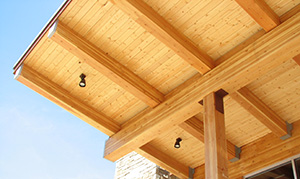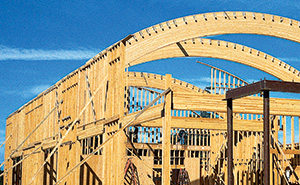 Glulam bending members are typically specified on the basis of the maximum allowable bending stress of the member. For example, a 24F designation indicates a member with an allowable bending stress of 2400 psi. Similarly, a 26F designation refers to a member with an allowable bending stress of 2600 psi. These different stress levels are achieved by varying the percentages and grade of higher quality lumber in the beam layup. Use of different species may also result in different stress designations.
Glulam bending members are typically specified on the basis of the maximum allowable bending stress of the member. For example, a 24F designation indicates a member with an allowable bending stress of 2400 psi. Similarly, a 26F designation refers to a member with an allowable bending stress of 2600 psi. These different stress levels are achieved by varying the percentages and grade of higher quality lumber in the beam layup. Use of different species may also result in different stress designations.
Visual vs. Mechanical Grading
To identify whether the lumber used in the beam is visually or mechanically graded, the stress combination also includes a second set of designations. For example, for an unbalanced 24F layup using visually graded Douglas-fir lumber, the layup designation is identified as a 24F-V4. The "V" indicates that the layup uses visually graded lumber. A 24F-E4 beam would indicate a mechanical graded lumber. The number "4" further identifies a specific combination of lumber used to which a full set of design stresses such as horizontal shear, MOE, etc., are assigned.
Axis Orientation
Glulam beams are typically installed with the wide face of the laminations perpendicular to the applied load. These are commonly referred to as horizontally laminated members. If this same member is rotated 90 degrees such that the load is applied parallel to the wide face of the laminations, it is considered to be a vertically laminated member. Glulam members have different tabulated stress properties depending on whether the member is used in a horizontal or vertical orientation.
 Balanced Glulam Beams
Balanced Glulam Beams
These members are symmetrical in lumber quality about the mid-height. Balanced beams are used in applications such as cantilevers or continuous spans, where either the top or bottom of the member may be stressed in tension due to service loads. They can also be used in single span applications, although an unbalanced beam is more efficient for this use.
 Unbalanced Glulam Beams
Unbalanced Glulam Beams
The most critical zone of a glulam bending member with respect to controlling strength is the outermost tension zone. In unbalanced beams, the quality of lumber used on the tension side of the beam is higher than the lumber used on the corresponding compression side, allowing a more efficient use of the timber resource. To assure proper installation of unbalanced beams, the top of the beam is clearly stamped with the word "TOP." Unbalanced beams are primarily intended for simple span applications.
Appearance Classification
Glulam is available in a range of appearances, all looking different but having the same structural characteristics for a given strength grade.
- Framing appearance is intended only for use in concealed applications.
- Industrial appearance is used where appearance is not of primary importance.
- Architectural appearance beams have a smooth, attractive finish intended to be exposed to view in the finished structure.
- Premium appearance beams are available on custom order where finished appearance is of primary importance.
 Camber
Camber
While any wood bending member can be designed to minimize deflection, glulam is the only engineered wood product that can be easily cambered to reduce the aesthetic effect of in-service deflections. The glulam industry recommends that roof beams be cambered for 1-1/2 times the calculated dead load deflection. This will generally be sufficient to assure that the beam will not exhibit a sag over a period of many years of loading, as may occur with non-cambered wood products. To achieve a level profile it is recommended that floor beams be only cambered for 1.0 times the calculated dead load deflection.
Most residential applications require very little or no camber which, in turn, makes glulam the ideal choice. See APA Technical Note: Glulam Beam Camber, Form S550, for more information. If, however, more camber is required, such as for a long span roof beam, custom beams are available through manufacturers to meet the most exacting specifications. Check the availability and added cost for the camber, if any, with the supplier.